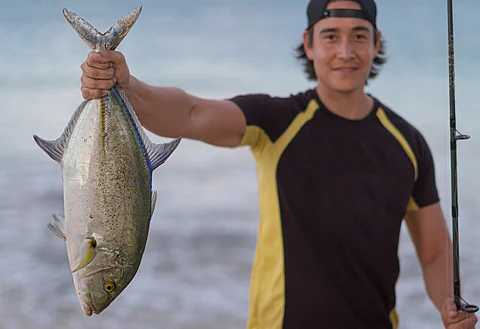

Marine Protected Areas have a positive "spillover" effect, producing more "trophy-size" fish just outside of the fully protected areas, and the effect is growing stronger over time, according to new research by the University of Hawaiʻi.
Photo: Adobe Stock.
Marine Protected Areas (MPAs) are a "win-win" for both ocean conservation and recreational fishing, according to new research by the University of Hawaiʻi at Mānoa.
The study found that fisheries adjacent to these protected areas see a significant boost to the numbers of "trophy-size" fish - exceptionally large or heavy fish prized by anglers for their rarity - and that this beneficial "spillover" effect of MPAs also strengthens over time.
Conducted by the Hawaiʻi Institute of Marine Biology (HIMB), and published in July in Science Advances, the research represents the first comprehensive global assessment of MPAs and their impact on recreational fisheries.
Principal investigator Simone Franceschini, a postdoctoral researcher at HIMB, explained in a media release that the study confirms the effectiveness of MPAs in enhancing fish biomass and benefiting local fisheries.
"Our study found that MPAs may take more than 20 years to show tangible spillover effects in the adjacent areas, which helps to set realistic expectations about the timeframe over which a marine reserve can be expected to have this type of effect on surrounding fisheries," Franceschini said.
The Hawaiian archipelago hosts 13 state and federal MPAs. Last year, the US Government announced it would establish a new Marine Protected Area in the Pacific, south-west of Hawaiʻi, “three times the size of Texas”.
Photo: Adobe Stock.
The Hawaiian archipelago, which hosts 13 state and federal MPAs, serves as a model for understanding the broader implications of marine conservation, the researchers say. These areas, managed by the State of Hawaiʻi Division of Aquatic Resources, demonstrate the potential of MPAs to secure marine biodiversity while benefitting local communities.
Elizabeth Madin, co-author of the paper and associate professor at HIMB, emphasized that the study replicates previous findings from Florida on a global scale.
"We show that, on average, highly-protected marine ecosystems produce tangible, real-world, long-term benefits for recreational fishers, resulting in a win-win situation for nature and people alike," Madin said.
However, she cautioned that not every MPA will yield the same results, highlighting the need for community support, enforcement, and effective fisheries management.
The University of Hawaiʻi also says the new research carries "significant implications" for the global "30×30" marine conservation initiative, which aims to protect 30% of the world's oceans by 2030.
Co-author John Lynham, a UH Mānoa professor of economics, noted the study's importance in providing evidence-based guidance for MPA implementation. "It’s intriguing to note that various MPAs around the world, despite their differing sizes and characteristics, have demonstrated a similar positive spillover effect and a similar ‘wait time’: roughly 20 years," Lynham observed.
The researchers say these findings also emphasize the need for "practical expectations" about the potential benefits of MPAs for local fisheries: "While MPAs can lead to substantial increases in the abundance of large fish, these benefits often require decades to materialize. This requires patience and long-term commitment from policymakers and local communities to maintain support for conservation efforts," the team point out.
However, marine protected areas can also show benefits to local communities more rapidly, and within 10 years of operation, according to Callum Roberts, lead author of the original 2001 study on which the latest research builds.
"Local fishers will see benefits to their catches from spillover of smaller fish long before that spillover becomes detectable in the form of large trophy fish, which take longer to reach record-breaking sizes," Roberts said.
"So, well-protected MPAs can help support local livelihoods within a decade of creation," he concluded.
*The full research study, "A global test of MPA spillover benefits to recreational fisheries", published in Science Advances (July 2024), can be read online here.
